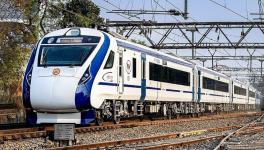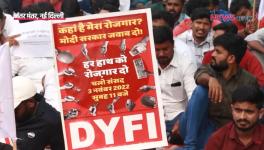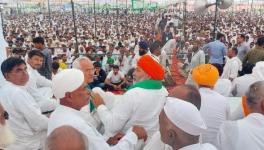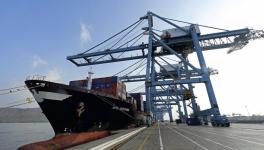J&K: World’s Tallest Upcoming Rail Bridge Brings Gloom to Himalayan Villages
Rajinder Singh at his defunct and now dilapidated wood and stone water mill in village Sermeghan.
Tucked away in the Sivalik Hills of Jammu and Kashmir’s Reasi district, the “next-man-made-wonder” is in the making. This engineering marvel is going to be five times the height of Qutub Minar in New Delhi and 35 metres taller than the iconic Eiffel Tower in Paris. Upcoming Chenab railway bridge — which is likely to be completed by 2022 — is supposedly going to open the gates for tourism, industry and development in the region.
But despite all the media hoopla around the bridge — which is being built between Bakkal and Kauri at a height of 359 metres above the waters of the Chenab river — residents of the Bhomag block are anything but excited over the ambitious railway project, which is aimed at connecting Kashmir Valley with the rest of the India. Instead, the bridge has brought only gloom to the villagers.
A view of under construction railway bridge in Bakkal village of Reasi district.
The area that once had gushing brooks and pristine water bodies, has been facing one of the worst water crisis in its history. Due to construction of a railway tunnel — which aims for connecting the upcoming bridge — all the fresh water sources in the villages of Bhomag block have disappeared completely.
The water that gushes out of the tunnel, according to local residents, is neither useful for the livestock nor the crops as its mixed with chemicals due to heavy use of spray concrete inside the tunnel.
Also read: J&K: No Process Initiated for Implementation of Forest Rights Post Abrogation of Art 370
The water crisis has thrown the normal life of the residents out of gear. Shakuntla Devi, 42, has to now take a five to six hour trek through steep and rugged mountain tracks to fetch water every day. Her husband, Prem Nath, 48, also takes the same route to get the grains ground at an electric mill — which remains functional only for a few hours during the day due to power outages. And their neighbour, Rajinder Singh, 38, once a proud owner of a water-powered wood and stone mill, has to hunt for menial jobs for subsistence.
“When the construction work started, we were told that the bridge would bring prosperity to the village. That we will get jobs and tourism,” said Jagjeevan Ram, 45, a resident of Sermeghan near Tunnel 5, and lamented in the same breath, “instead of benefits, the development has brought us disaster. How can one live happily without water?”
The Indian Railways is currently constructing over a dozen tunnels in the district and people in the rest of the areas have also been facing the same problems, according to local officials. When the water sources in the area started drying up gradually, the villagers said, they were told that the fresh water sources would automatically get revived. But the reality of the ecological disaster has dawned upon them about seven monsoon seasons later, they claimed.
In fact, after the local residents raised a hue and cry, the work executing agencies, Konkan Railway Corporation Limited, the Northern Railway and the local administration, started supplying drinking water through truck tankers.
A view of a dry river bed in parched Sermeghan village in Bhomag block of Reasi district.
Ashok Thakur, block chairman of Bhomag, said, “While the drinking water requirement of each hamlet is 10-12 water tankers on a daily basis, residents get only 2-3 tankers. Still the supply is not regular. Half of the village now has to spend as long as five to six hours a day for collecting water.”
“But tankers can’t be an alternative to the natural sources of water,” he said and added, “Over 14 water mills in my block are lying defunct now. In just Kansar and Bakkal village, farmers now can’t grow paddy in over 62 acres as they have nothing to irrigate the farms. The agriculture has become totally dependent on rain.”
Even though the bridge work had started in 2004, since then, the work has been stalled over several issues including safety concerns on various occasions.
Initially, the village population was split between those who believed that the project would bring them jobs at the construction site and those who were against the project. Today, the villagers complain that the construction companies don’t give them any jobs at the construction site.
“They prefer labour from Bihar, Madhya Pradesh, Chhattisgarh and Jharkhand. The contractors can easily exploit them as per their free will. Being outsiders, they can’t raise their voice. But, the local labourers get organised within no time to assert their rights if they don’t get their full wages in time. Initially, the local labourers from the surrounding villages were engaged in the construction activities,” said Mohan Lal, 45, a local resident who worked as a day labourer at the under construction bridge site a couple of years ago, as others sitting around him nod in agreement.
Also read: Kashmir Nurtures Jobless Brigade
Similarly, they add, they don’t have any hopes that the project would provide jobs to them in the future either. “It’s the rich people from cities who have been purchasing land in the area for setting up their businesses in near future. We will again get only menial jobs at their hotels, restaurants and shops. Only the rich will pocket the profit from prospective tourist footfall in the area,” said one of the residents.
Recently, Prime Minister Narendra Modi reviewed the progress of the project and reportedly gave explicit instructions on its speedy completion.
The villagers fear that once the railway authorities leave the area after completing the project, they would no longer get the supply of even drinking water. “Many villagers, who are economically well off, are planning to migrate to other areas,” claimed Thakur.
The district administration, meanwhile, has directed the Central Ground Water Board to conduct a survey and find alternative sources of water. It has also been focusing on water conservation projects in all the water stressed villages.
“In the district, villages around 14 railway tunnels have been hit (by water crisis) owing to the damage to the aquifers. But it’s not going to be a long-lasting problem,” District Development Commissioner Indu Kanwal Chib avers, adding that, “at the time of completion of a tunnel, a waterproof membrane is used to seal the structure. It eventually leads to groundwater recharge and revival of the water sources.”
Also read: Bullet Train Project a "Climate-Negative" Action, 80,000 Trees, Shallow Aquifers to Be Hit: Report
But the experts remain sceptical. “In case the groundwater channels have been completely cut or blocked and diverted in reverse direction, the old water sources won’t get revived in villages even after the installation of a waterproof membrane inside the tunnels. But there is every possibility that the water may unexpectedly emerge at other places in future,” G.M. Bhat, a geologist and rector at the Bhaderwah campus of the University of Jammu said.
“It’s compulsory for all the developmental projects that environmental impact assessment and environmental management plan should be in place before the project construction is undertaken. Had the work executing agencies followed recommendations of the geologists or hydrologists, this crisis could have been avoided. The engineers should have taken the underground water courses into consideration before and during the excavation work,” he asserted.
Many villagers, however, share District Development Commissioner’s optimism. They continue to perform rituals at the local ‘Nag Devta’ (Snake God) temple, which sits near what was once the origin of a gushing stream. They believe their prayers will reach the water gods.
The writer is an independent journalist based in Jammu and Kashmir.
Get the latest reports & analysis with people's perspective on Protests, movements & deep analytical videos, discussions of the current affairs in your Telegram app. Subscribe to NewsClick's Telegram channel & get Real-Time updates on stories, as they get published on our website.























